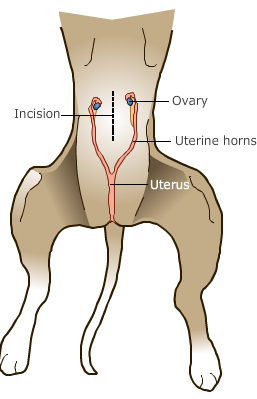Spaying
Call Now
Spaying
Spaying refers to the surgical procedure performed on female animals to render them infertile. There are many benefits to spaying your female companion. First, you will contribute to the prevention of dog and cat overpopulation. Second, spaying will eliminate the sometimes ‘messy’ heat cycles that attract male cats/dogs to your house from miles away. Third, you will help prevent diseases in your pet, such as pyometra (infection in the uterus) and mammary cancer.
Spaying involves surgical removal of the ovaries with our surgical laser procedure, and for those receiving laparoscopic surgery, the ovaries and uterus are removed as well. This surgery can be performed under a number of anesthetics and monitoring devices.
Safe, Smooth & Successful Surgery
Blood work gives us a wealth of information about your pet, including details on your pet’s ability to metabolize drugs and clot a bleeding wound. Pre-surgical blood work gives you and our staff peace of mind before beginning your pet’s surgery. If your pet’s blood work shows abnormalities in kidney or liver function, or in your pet’s clotting factors, we can take precautions and make the appropriate adjustments to our surgical protocols to ensure your pet’s surgery goes smoothly.
There are several monitoring devices that can be used during your pet’s anesthetic. At our clinic, a technician continually assesses your pet’s vital signs during the procedure. Your pet will also be monitored by VetSpec PM6 which records body temperature, oxygen level, respiration rate, and blood pressure every 3 minutes. This information is then printed and kept in your pets file. Although the risk of an anesthetic death in a normal healthy pet is very rare, monitoring devices and procedures allow for a fast response to an anesthetic emergency. Fast responses can save lives. Please call or visit our facility to learn more about our neutering procedures.
*At AVC, we strongly recommend waiting until your pet’s growth plates have fully closed before spaying/neutering. The closure of these plates is dependent upon the sex hormones released throughout puberty. Just as in humans, puberty and sexual maturation is imperative for your pet’s bone, brain and organ development. Neutering or spaying your pet before they’ve had a chance to reach this developmental stage in their life can cause abnormal bone growth which often leads to orthopedic disorders including hip dysplasia and osteosarcoma (bone cancer). In females, 5-20% of those who are spayed before reaching puberty will suffer from estrogen-responsive urinary incontinence (also known as “Spay-Incontinence”).The traditional spay/neuter age of six months as well as the modern practice of pediatric spay/neuter appear to predispose dogs to health risks that could otherwise be avoided by waiting until the dog is physically mature.¹ Physical maturation depends on the size and species of the animal. Cats and small dogs should be sterilized after 6 months, medium to large breed dogs after 6-8 months and giant breeds should remain intact for at least a year before sterilization as they take considerably longer to mature and, by nature of their size, are predisposed to orthopedic disorders. Visit the links below to continue reading about early spay or neuter considerations.
Traditional Spays
In a traditional spay, a 2” to 3” or larger incision is made in the abdomen through which the ovarian ligament is blindly torn from the abdominal wall with a scalpel. This tearing may cause bruising and postoperative pain. Traditional spays require significant tension on the ovaries and uterus, which may cause trauma and bleeding. Traditional spays are typically performed as in-patient surgeries that require an overnight stay. *This type of spay is not offered at our clinic.
Laser Spays
Laser Spays are performed in a manner similar to traditional spays, except a CO2 surgical laser is used rather than a scalpel. Because there is no physical contact between the laser and the surgical region, the tearing and bruising of tissue associated with the traditional surgical method are eliminated. There is significantly less bleeding, less scarring, and less pain for the animal, thanks to the laser’s cauterizing effect on both small blood vessels and nerve endings. These benefits result in a faster recovery period, making the Laser Spay an outpatient procedure (patients can go home within hours after waking up from surgery).
Laparoscopic Spays
What is Laparoscopy?
Laparoscopy is a minimally invasive technique for viewing the internal structures of the abdomen. A laparoscope (camera) inserted through a small incision in the abdomen magnifies internal structures of the abdomen on a TV monitor for a more thorough examination. Additional small incisions are made to facilitate the use of surgical instruments. The most common application of laparoscopy is a biopsy. In recent years, laparoscopy has been adopted as a less traumatic and less painful alternative to traditional spays.
When performing a laparoscopic spay, the procedure is done through two or three tiny incisions in the abdomen, typically 3/16” in size. The procedure is performed with magnified views of the organs allowing for greater precision. The ovarian ligament is carefully cut and cauterized by laser rather than torn with a scalpel. Laparoscopic spays have been shown to reduce post-operative pain in patients by up to 65%,* minimal recovery time and less trauma than traditional spays. The Laparoscopic spay is also an outpatient procedure.
Advantages of Laparoscopic Spay:
- A recent study concluded laparoscopic spays caused less surgical stress and up to 65% less post-operative pain than a traditional open surgical spay.*
- The entire surgery is performed through a few tiny incisions rather than a larger abdominal opening. Smaller incisions are less painful and reduce recovery time.
- Allows for excellent visualization of abdominal organs.
- Controlled incisions eliminate pain and bruising caused by the tearing of tissue associated with traditional spays.
- In larger breed dogs, gastropexy can be performed at the time of spay.
*Devitt, Chad, DVM, MS, DACVS. “Duration, Complication, Stress, and Pain of Open Ovariohysterectomy Versus a Simple Method of Laparoscopic-Assisted Ovariohysterectomy in Dogs.” Journal of the American Veterinary Medical Association Volume 227, Number 6 (September 15, 2005).
Veterinary care delivered with compassion for the pets of Saskatoon for over 35 years.
Acadia Veterinary Clinic and Pet Rehab Centre is a full-service veterinary hospital in Saskatoon, SK. We're pleased to provide compassionate veterinary care and pet rehabilitation. We want to offer the best care for your best friend!
Contact Info
Hours
Mon-Fri: 8:30am-5:30pm
Sat: 8:30am-3:00pm
Sun: Closed
Location
3421 8th Street East #4
Saskatoon, SK S7H 0W5
Click here for directions.


